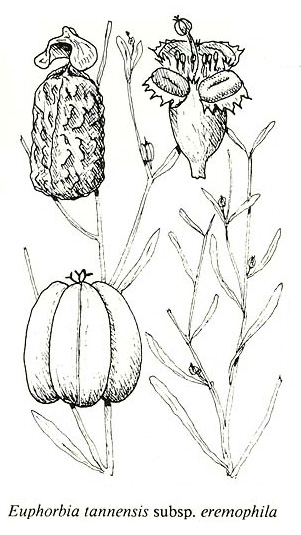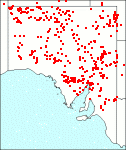|
Euphorbia tannensis
Citation:
Sprengel, Fl. Hal. Mant. 42 (1807) subsp. eremophila (Cunn. ex Hook.)Hassall, Aust. J. Bot. 25:439 (1977).
Synonymy: E. eremophila Cunn. ex Hook. in T.L. Mitchell, J. Trop. Austral. 348 (1848); E. tannensis Sprengel subsp. eremophila (Cunn. ex Hook.)Hassall var. eremophila (Cunn. ex Hook.)Hassall, Aust. J. Bot. 25:439 (1977); Croton clutioides Forster f., Fl. Ins. Aust. Prod. 92 (1786), nom. nud.; E. clutioides (Forster f.)C. Gardner, J. R. Soc. W. Aust. 17:181 (1942), nom. illegit.; E. finlaysonii J. Black, Trans. R. Soc. S. Aust. 59:258 (1935); E. tannensis Sprengel subsp. eremophila (Cunn. ex Hook.)Hassall vat. finlaysonii (J. Black)Hassall, Aust. J. Bot. 25:441 (1977).
Common name: Desert spurge, caustic bush (or plant), spurgewort, bottletree caustic.
Description:
Erect glabrous annual to perennial herb, usually 5-50 cm high (in S.Aust.), sometimes to 1 rarely 1.5 m tall, sometimes shrubby, arising from a tap root, branching at some distance above the ground, becoming woody on lower parts of the branches and stem, green, glaucous, brownish on woody parts; leaves alternate below, almost opposite in the upper parts, with petioles up to 4 mm long; blades linear to narrowly ovate, 5-70 x 1-7 mm, obtuse to acute, tapering to the petiole or cuneate, entire or serrulate; stipules subulate, c. 0.2 mm long.
Cyathia solitary, terminal or axillary on peduncles to 1 mm long; involucre campanulate, c. 1.5 mm long, intervening lobes bent inwards; glands more or less elliptic, c. 1 mm long, yellow to red, margins entire or crenulate to palmatifid (often varying on the same specimen); male flowers usually with 4 glabrous stamens in 5 bundles; bracteoles plumose; styles 3, erect, each cleft to the middle into 2 filiform recurved stigmas.
Capsule erect, ovoid-globose, 3-lobed, 4-5 mm long and wide, keeled on the back, smooth, green; seed quadrangular-oblong, 2.5-3 x 1.7-2 mm, smooth to undulate or somewhat wrinkled to finely or roughly granular, sometimes white-crusted, the ventral raphae keeled, grey to brown; caruncle hat-shaped, c. 1.5 mm across, more or less raised above the seed, yellow-brown, persistent.

| Euphorbia tannensis subsp. eremophila twigs, cyathium, fruit and seed.
|
Image source: fig 403a in Jessop J.P. & Toelken H.R. (Ed.) 1986. Flora of South Australia (4th edn).
|
Published illustration:
Hurst (1942) Poison plants of New South Wales, p. 228; whittel (1958) Weeds (N.S.W. Dept Agric.), fig. 119; Cunningham et al. (1982) Plants of western New South Wales, p. 456 as E. eremophila.
|
|
Distribution:
|
Variable, on heavy clay soils of river and floodplains or skeletal hillside soils, from open grass plains to mulga communities.
All States except Tas.
|
Conservation status:
native
Flowering time: most of the year.
|

SA Distribution Map based
on current data relating to
specimens held in the
State Herbarium of South Australia
|
Biology:
Plants eventually appearing leafless except often only for a couple of terminal leaves at each cyathia. Containing copious milky sap. A reported case of poisoning in horses (Chippendale & Murray (1963) Northern Territory administration animal industry branch extension article no. 2, edn 2.)
Author:
Not yet available
|

